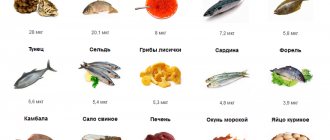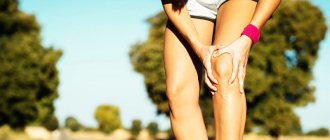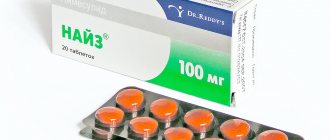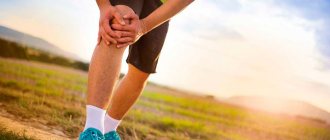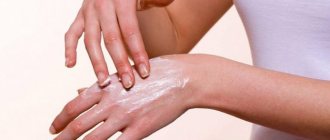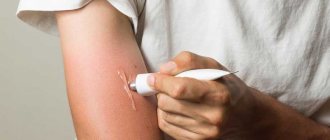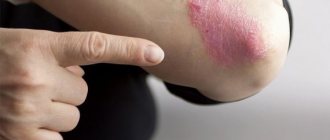Pharmacokinetics and pharmacodynamics
The nonsteroidal anti-inflammatory drug is characterized by antipyretic, analgesic, and anti-inflammatory effects. The effect of phenylbutazone is due to its ability to suppress the activity of cyclooxygenases, resulting in inhibition of the process of prostaglandin synthesis. The substance also produces the process of reabsorption of salts and water in the renal tubules.
According to the instructions for Butadione tablets, under the influence of the drug, pain is eliminated and swelling that accompanies the inflammatory process is reduced. The therapeutic effect is to increase the range of motion of the affected joint, restore its mobility, and reduce pain during movement or at rest. The anti-inflammatory effect of phenylbutazone is superior to that of Amidopyrine.
If the drug is used for the treatment of gout, there is a twofold increase in the amount of urate excreted in the urine, as well as a noticeable decrease in their amount in the blood.
“Butadione” is effective for postoperative and hemorrhoidal thrombophlebitis, which is reflected in a decrease in the degree of inflammation and pain.
Absorption of the active substance when applying the ointment reaches no more than 5%. Phenylbutazone is metabolized in liver tissue, after which its metabolites are evacuated primarily by the kidneys, and partially by the intestines. It is cleared from blood plasma for quite a long time - about 70 hours. In elderly patients, this period can take up to 105 hours.
The absorption of the active component when using the tablet form of the drug is very high, and bioavailability can reach 90%. The highest concentration of phenylbutazone in the blood is observed after 2 hours. Then the active component enters all tissues and organs, penetrates the joint cavities and through the blood-encephalitis barrier. Metabolism occurs in the liver tissue, half of the entire dose is excreted after 24 hours. Excretion is carried out by the gastrointestinal tract and kidneys.
Use of the drug
When using the tablet form of the drug, adult patients should use 200 mg of the drug per dose. In this case, the daily dosage can reach 600 mg. The duration of therapy is determined by the doctor taking into account the severity of the pathology. If a patient with diabetes insipidus takes 400 mg of Butadione per day, a decrease in the amount of urine may be observed.
Children over 12 years of age are recommended to use 75 mg of the drug three times a day. You can reduce the irritating effect of the active component on the gastric mucosa by drinking milk.
If Butadion is used for the treatment of joint diseases, its effect can be increased by parallel use of prednisolone (it should be administered intravenously, by drip).
Pharmacokinetics and pharmacodynamics
The nonsteroidal anti-inflammatory drug is characterized by antipyretic, analgesic, and anti-inflammatory effects. The effect of phenylbutazone is due to its ability to suppress the activity of cyclooxygenases, resulting in inhibition of the process of prostaglandin synthesis. The substance also produces the process of reabsorption of salts and water in the renal tubules.
According to the instructions for Butadione tablets, under the influence of the drug, pain is eliminated and swelling that accompanies the inflammatory process is reduced. The therapeutic effect is to increase the range of motion of the affected joint, restore its mobility, and reduce pain during movement or at rest. The anti-inflammatory effect of phenylbutazone is superior to that of Amidopyrine.
You may be interested in: Pentaxim vaccine: reviews, composition, instructions for use
If the drug is used for the treatment of gout, there is a twofold increase in the amount of urate excreted in the urine, as well as a noticeable decrease in their amount in the blood.
“Butadione” is effective for postoperative and hemorrhoidal thrombophlebitis, which is reflected in a decrease in the degree of inflammation and pain.
Absorption of the active substance when applying the ointment reaches no more than 5%. Phenylbutazone is metabolized in liver tissue, after which its metabolites are evacuated primarily by the kidneys, and partially by the intestines. It is cleared from blood plasma for quite a long time - about 70 hours. In elderly patients, this period can take up to 105 hours.
The absorption of the active component when using the tablet form of the drug is very high, and bioavailability can reach 90%. The highest concentration of phenylbutazone in the blood is observed after 2 hours. Then the active component enters all tissues and organs, penetrates the joint cavities and through the blood-encephalitis barrier. Metabolism occurs in the liver tissue, half of the entire dose is excreted after 24 hours. Excretion is carried out by the gastrointestinal tract and kidneys.
Compound
The main component of the drug is phenylbutazone.
The following are used as excipients in the manufacture of Butadione tablets: silicon dioxide, sodium bicarbonate, primellose, talc, magnesium stearate, potato starch.
Auxiliary components in the ointment are: liquid paraffin, water, propylene glycol, glycerol, polysorbate, sodium carboxymethylcellulose, silicon dioxide, methyl parahydroxybenzoate.
The drug is capable of having analgesic and anti-inflammatory effects.
Pharmacological properties
The drug has the following properties:
- It affects inflammatory mediators, so you can quickly cope with the inflammatory process. At the same time, prostaglandins, which intensify and increase the duration of pain, are produced in smaller quantities;
- Has analgesic properties. But the drug does not have a systemic effect. Therefore, it is used in the fight against severe irritation and discomfort in certain areas. It cannot be used simultaneously with other analgesics, as this will cause side effects.
The drug is practically not absorbed into the local bloodstream. The active substance accumulates in greatest concentration at the site of application.
The medicine is absorbed in the liver, and its remains are excreted through the urinary system. No salt residues are formed.
Interaction
The interaction of the ointment with other drugs has not been described. May enhance the effect of photosensitizing drugs. It is necessary to avoid the simultaneous use of Butadione with other NPVs.
Taking tablets enhances the effect of antiplatelet agents, fibrinolytics and indirect anticoagulants. Increases the side effects of glucocorticosteroids, estrogens, morphine , penicillin. Enhances the effect of hypoglycemic drugs of sulfonylurea derivatives.
Reduces the effectiveness of antihypertensive drugs and diuretics.
Phenytoin, barbiturates, ethanol, tricyclic antidepressants and rifampicin increase the production of active metabolites of the drug. Cholestyramine and antacids reduce the absorption of butadione.
Butadione contraindications
The drug Butadione is contraindicated for the following ailments: kidney dysfunction, liver dysfunction, impaired blood circulation, diseases of the hematopoietic system, ulcers of the 12th intestine, stomach, arrhythmia, as well as during breastfeeding and pregnancy.
It is not recommended to take Butadione: for trophic ulcers, eczema and other skin lesions.
You should take the medicine Butadione with caution: for edema, hemophilia, bronchial asthma, chronic heart failure, hyperbilirubinemia, hypertension, diabetes mellitus, stomatitis, renal failure, blood diseases, gastrointestinal tract and hearing impairment. You can take increased dosages of Butadion without fear! Its active substance Phenylbutazone is absorbed into our blood in a limited manner, under the control of the body, which eliminates the risks of butadione overdose
And this is true - cases of overdose are not known to medicine, and reviews of the drug Butadione are mostly positive. Even if any of its first signs appear, the treatment changes: the dose of butadione may simply be reduced or other NSAIDs may be prescribed
You can take increased dosages of Butadion without fear! Its active substance Phenylbutazone is absorbed into our blood in a limited manner, under the control of the body, which eliminates the risks of an overdose of butadione. And this is true - cases of overdose are not known to medicine, and reviews of the drug Butadione are mostly positive. Even if any of its first signs appear, the treatment changes: the dose of butadione may simply be reduced or other NSAIDs may be prescribed.
Price
| Release form | Quantity | Cost of the drug Butadion in Russia: | Cost of the drug Butadion in Ukraine: |
| Pills | 20 pieces per pack of 0.15 g | from 130 rubles | from 150 hryvnia |
| Pills | 10 pieces per pack of 0.15 g | from 70 rubles | from 100 hryvnia |
| Ointment | 20 g | from 150 rubles | from 80 hryvnia |
Conditions for dispensing from pharmacies
Butadione ointment and tablets are available from pharmacies freely without a prescription.
Mechanism of action
The drug belongs to the category of non-steroidal anti-inflammatory drugs. Butadione helps cope with inflammation, relieves pain and reduces fever. The activity of the substance is aimed at suppressing cyclooxygenases. This leads to inhibition of prostaglandin production. The substance stimulates the reabsorption of water and salts by the kidneys.
Butadione eliminates pain and swelling during inflammation. The therapeutic effect is manifested in a decrease in pain in a calm state and during movement, and normalizes the activity of the joints.
The product provides good results for thrombophlebitis. Thanks to the use of this medicine, it is possible to cope with pain and relieve inflammation.
Patient reviews
I had a toothache for several days. I took painkillers, but it didn’t help. I made an appointment with the dentist. The canal was cleaned and a filling was installed. After anesthesia, the doctor warned that there would be pain. I recommended drinking Butadion. By following the dentist’s recommendations, I was able to prevent the consequences of anesthesia and the manipulation itself.
Svetlana, 27 years old
For several years I have been using Butadion ointment when I sunbathe. With this product you can prevent sunburn. After the beach I always apply the composition to my skin. In the morning the skin does not peel off or turn red.
Alina, 29 years old
I like to lead an active lifestyle. When playing sports, I often stretch my muscles. My fitness trainer advised me to use Butadion ointment. After each injury, I treat the damaged area with the composition twice a day. The advantage of the product is that there is no need to prepare a compress. After 3 days of therapy, the stretched muscles stop hurting. Pain and other discomfort disappear.
Vitaly, 32 years old
I was diagnosed with osteoarthritis.
The doctor prescribed Butadion. Since the disease was accompanied by pain and inflammation, the drug was used three times a day. On day 2, the symptoms began to subside. A few days later the pain went away and the condition improved. Natalya, 43 years old
Side effects of Butadion
Butadione tablets may cause the following side effects:
- irritation of the gastrointestinal mucosa;
- vomiting, diarrhea, nausea;
- neuritis;
- skin rashes;
- hematuria.
With prolonged use of the drug in tablet form, exacerbations of peptic ulcer disease may occur.
According to the instructions, Butadione in the form of an ointment can cause hives, itching and other skin reactions.
Butadione in any dosage form has an inhibitory effect on the hematopoietic organs, which in some cases can lead to the development of agranulocytosis, leukopenia, anemia or thrombocytopenia.
If any allergic reactions occur, the drug should be discontinued.
To reduce the irritating effect of the drug on the mucous membrane, it is recommended to take it during or immediately after meals with a small amount of milk.
Since the use of Butadione reduces the excretion of sodium ions in the urine and increases the accumulation of water in the body, the condition of patients with hypertension or cardiovascular failure may worsen.
Negative Impacts
With the use of Butadione tablets, more pronounced systemic reactions may develop:
- Thrombocytopenia, leukopenia, agranulocytosis, anemia.
- Noise in ears.
- Dizziness, agitation, depression, drowsiness, headache.
- Increased blood pressure.
- Impaired liver function.
- Gingival, hemorrhoidal, intestinal, stomach bleeding.
- Aphthous stomatitis.
- Diarrhea, heartburn.
- The appearance of ulcerations on the mucous membranes of the gastrointestinal tract if the drug is used for a long time or in large dosages.
- Vomiting, nausea.
- Dyspepsia, abdominal pain.
If the patient experiences changes in blood composition, therapy using Butadion should be discontinued. As a result of the retention of water and sodium in the body caused by taking the drug, the condition of patients with hypertension and CHF may worsen. Such manifestations also require physician intervention and adjustment of the treatment regimen.
This is what it says in the instructions for use for Butadione tablets. We will consider analogues below.
Contraindications
The ointment should not be used in case of hypersensitivity, applied to open wounds, including eczema and trophic ulcers, and used with extreme caution during pregnancy and lactation. Due to their systemic effect on the body, tablets have many more contraindications
For example, they cannot be used for the “aspirin” triad, erosive lesions of the gastrointestinal tract, especially in the acute stage, bone marrow depression, pulmonary-cardiac, renal or liver failure. There is a potential risk for bronchial asthma, edema, hemophilia, hearing loss and a number of other diseases
Due to their systemic effect on the body, tablets have many more contraindications. For example, they cannot be used for the “aspirin” triad, erosive lesions of the gastrointestinal tract, especially in the acute stage, bone marrow depression, pulmonary-cardiac, renal or liver failure. There is a potential risk for bronchial asthma, edema, hemophilia, hearing loss and a number of other diseases.
special instructions
Butadion ointment should not be applied under a sealed bandage, on damaged skin, or allowed to come into contact with mucous surfaces of the body.
If the skin becomes red at the application sites, stop using the product.
The ointment is not intended for the treatment of deep vein thrombophlebitis.
To reduce the risk of negative effects of tablets on the gastrointestinal system, it is necessary to take the minimum effective dose for a short period.
While taking Butadion, you should not engage in driving or other activities that require quick physical and mental reactions.
Taking medication with caution
This drug should be taken with caution in case of hyperbilirubinemia, bronchial asthma, chronic heart failure, edema, arterial hypertension, hemophilia, hypocoagulation, liver failure, chronic renal failure, hearing loss, pathology of the vestibular apparatus, blood diseases, diabetes mellitus, systemic lupus erythematosus, rheumatic polymyalgia, transient arteritis, ulcerogenic pathologies of the gastrointestinal tract, stomatitis, coronary heart disease, cerebrovascular diseases, dyslipidemia/hyperlipidemia, peripheral arterial diseases, tobacco smoking, creatinine clearance less than 60 ml/min, history of ulcerative lesions of the gastrointestinal tract, presence of Helicobacter pylori infection, in old age , long-term use of NSAIDs, alcoholism, severe somatic diseases, simultaneous use of oral glucocorticosteroids (prednisolone), anticoagulants (warfarin), antiplatelet agents (acetylsalicylic acid, clopidogrel), selective serotonin reuptake inhibitors (citalopram, fluoxetine, paroxetine, sertraline), in I- II trimester of pregnancy, lactation period
Contraindications for use
The medication is not recommended for use if the patient has the following pathological or physiological conditions:
- With the parallel use of other medications based on phenylbutazone.
- The patient's age is less than 12 years.
- Insufficiency of liver or kidney activity.
- First and third trimester of pregnancy.
- Hyperkalemia.
- Suppression of bone marrow activity.
- Heart rhythm disturbances.
- Decompensated form of CHF.
- A history of bleeding in the gastrointestinal tract.
- The period of exacerbation of ulcerative colitis and peptic ulcers.
- The presence of hypersensitivity to phenylbutazone.
- Hypersensitivity to acetylsalicylic acid.
Instructions for use for Butadione tablets must be strictly followed.
Indications for use
Butadione is used for the following conditions:
- Post-traumatic inflammation of joints and soft tissues (sprains, bruises, overexertion during training).
- Rheumatic diseases of soft tissues - bursitis, tendovaginitis, damage to periarticular tissues.
- Muscle pain of various origins.
- Pain and swelling due to inflammatory joint and muscle diseases.
- Arthritis.
- Spondylitis
- Osteoarthritis.
- Lumbago.
- Radiculitis.
- Sciatica.
- Pain syndrome of various etiologies with myalgia, algodismenorrhea, neuralgia, arthralgia, toothache and headache.
- Pain from burns and injuries.
- Fever due to infectious diseases and colds.
Instructions for use
Butadione is a drug that has anti-inflammatory, antipyretic, and analgesic effects . Can be used externally and orally depending on the release form.
pharmachologic effect
A nonsteroidal anti-inflammatory drug whose action is aimed at suppressing the activity of cyclooxygenases. This ensures inhibition of prostaglandin synthesis. Butadione eliminates swelling during the inflammatory process and also relieves pain.
A distinctive feature of Butadion therapy is the reduction of pain not only at rest, but also during movement . Thanks to this property, the range of motion of diseased joints increases.
For gout, the use of phenylbutazone increases the excretion of urate in the urinary fluid , which reduces its concentration in the blood.
For thrombophlebitis, the drug relieves the inflammatory process and relieves pain.
Release form, composition
Butadione is available in the form of ointments and tablets . The ointment has a thick, white consistency.
The ointment is produced in metallized tubes with a capacity of 20 g.
The drug is produced in tablets in quantities of 10 or 20 pieces in a package of 0.15 g for adults. For children, tablets - 0.03 and 0.05 g, 10 pieces in a blister pack.
| Release form | Main component | Excipients: |
| Ointment | phenylbutazone |
|
| Pills | phenylbutazone |
|
Indications for use
Butadion ointment is indicated for use in the following cases:
- rheumatic soft tissue disease: tendovaginitis, bursitis, damage to periarticular tissues;
- the presence of muscle pain of a rheumatic nature or non-rheumatic origin:
- rheumatoid arthritis;
- restoration and reduction of inflammation after bruises, overstrain or sprain of soft tissues or joints;
- the presence of radiculitis, sciatica;
- swelling of soft tissues due to muscle or joint disease;
- osteoarthritis;
- lumbago;
- hematomas of various sizes;
- thrombophlebitis of superficial venous vessels;
- inflammation of hemorrhoidal nodules;
- inflammation associated with injections;
- swelling as a result of an insect bite;
- burn damage to tissues of the first or second severity.
Butadione ointment is used to eliminate symptoms of inflammation and reduce (eliminate) pain.
Butadione tablets are used in cases:
- inflammatory or destructive processes of the musculoskeletal system: gouty arthritis, arthritis caused by lupus erythematosus, psoriatic arthritis, ankylosing spondylitis;
- the presence of pain of various etiologies (toothache, headache, tenosynovitis, migraine, bursitis, headache, arthralgia, pain after bruises, injuries, migraines, after burns);
- the presence of a febrile state against the background of colds or infectious diseases.
The tablets are used as symptomatic therapy ; the drug does not affect the rate of recovery.
Directions for use, dosage
Butadione ointment is applied externally.
For adults and children over fourteen years of age: squeeze the ointment two to three centimeters onto the affected area. Does not require intensive rubbing. Distribute the product over the surface. You need to apply the ointment two to three times a day. The course of treatment is no more than 10 days.
Important! When using the ointment, you do not need to apply a tight bandage. Just wait until the product is absorbed.
Butadione tablets are used orally after meals . The number of doses is three to four times during the day.
The dosage rate for adults is 150 mg tablet per dose, for children - 75 mg . The daily intake should not be more than 600 mg. To reduce irritation of the child’s gastric mucosa, it is permissible to drink milk after taking the tablet.
In some cases, ointment is used in parallel with tablets. This helps achieve maximum therapeutic effect. It is important to control the daily dosage of the drug.
Interaction with other drugs
When using Butadion ointment, no interactions with other drugs were noted..
Phenylbutazone can enhance the effects of photosensitizing agents . It is not recommended to use other non-steroidal anti-inflammatory drugs with ointment.
Tablets can enhance the effect of fibrinolytics, antiplatelet agents, and indirect anticoagulants .
With the parallel use of morphine, estrogens, penicillin, and glucocorticosteroids, the side effects from their use may increase.
Sulvonylurea derivatives, when taken in parallel with phenylbutazone, enhance their effect.
There is an increase in the production of active metabolites when Butadione is taken simultaneously with barbiturates, ethanol, phenytoin, rifampicin, tricyclic antidepressants.
Absorption of the drug is reduced when taking antacids and cholestyramine in parallel .
Video: “How are sore throat and rheumatism related?”
Drug analogues
“Butadione” has analogues among non-steroidal drugs for relieving inflammation. There are a large number of such medications, and they are sold in pharmacies without a doctor's prescription. Among the most popular and frequently used are:
- "Diclofenac". It is produced in the form of ointments, gels, injection solutions, rectal suppositories and tablets. The main component that ensures the effect of the drug is diclofenac sodium. Most often the product is used in the form of an ointment. It costs no more than 150 rubles;
- "Voltaren." The therapeutic effect is achieved with ointments and gel for external use. There is also an anti-inflammatory patch. This is a product from a Swiss manufacturer. The active substance is diclofenac. The drug has the same mechanism of action and has the same contraindications as its domestic counterparts. But its average cost reaches 500 rubles;
- "Troxevasin". The ointment and gel, which are applied to the affected areas, are produced in a two percent concentration. The cost is above 200 rubles;
- "Troxerutin." It is produced on the basis of troxevasin by Russian pharmaceutical companies. The medicine is sold in pharmacies at prices ranging from 60 to 200 rubles;
- "Ibuprofen." Using ointment, analgesic and antipyretic effects are achieved. The average price reaches 300 rubles.
It is not recommended to independently change the course of treatment or select other means to combat diseases without the permission of a doctor.
Butadion price, where to buy
You can buy it at any pharmacy in Moscow; to obtain information about the availability of the drug, you can use the data of the Federal Information Service www.poisklekarstv.ru. The price of Butadion ointment ranges from 104 rubles. up to 191 rub. Price of tablets 150 mg No. 20 from 35 rub. up to 67 rub.
- Online pharmacies in RussiaRussia
- Online pharmacies in UkraineUkraine
- Online pharmacies in KazakhstanKazakhstan
ZdravCity
- Butadione ointment 5% 20g JSC Gedeon Richter
RUB 245 order - Butadione ointment for nar. approx. 5% tube 20g No. 1Ozon LLC
RUB 151 order
Pharmacy Dialogue
- Butadione ointment (tube 5% 20g) Ozone LLC
134 RUR order
- Butadione ointment (tube 5% 20g) Gedeon-Richter
RUB 221 order
- Butadione (tab. 150 mg No. 20) Obolenskoye pharmaceutical representative.
132 RUR order
- Butadione (tab. 150 mg No. 10) Obolenskoye pharmaceutical representative.
79 RUR order
show more
Pharmacy24
- Butadione 0.05 g/1 g 20 g ointment VAT "Gedeon Richter", Ugorshchina
93 UAH. order
PaniPharmacy
- Butadione ointment Butadione ointment 5% 20g Hungary, Gedeon Richter
93 UAH order
show more
Possible adverse reactions
When using Butadione, local or systemic negative effects on the drug may appear:
- Nervous system – sudden dizziness (usually when standing up), headaches, neuritis (pathologies of inflammatory nerves associated with decreased sensitivity or movement disorders).
- Digestive system - nausea, vomiting, stomach pain, ulceration or perforation in the duodenum or stomach, gastric bleeding, pancreatitis, diarrhea.
- Liver failure.
- Urinary system - renal dysfunction (more often observed in people with kidney pathologies and the elderly), increased swelling due to fluid retention in the body, hematuria (bloody impurities in the urine).
- Hematopoietic organs - aplastic anemia, leukopenia or agranulocytosis (critical decrease in the number of leukocytes), thrombocytopenia (critical decrease in platelets).
- Allergic response - photosensitivity, erythema (redness of the skin), bronchial asthma or spasms in the bronchi, acute allergic pathology of the mucous membranes or skin, etc.
- Skin – dermatitis, rash, itching, eczema, urticaria, peeling and redness.
Detailed symptoms of intercostal neuralgia on the right. Description and treatment of the disease.
The article (link) treats arthralgia.
Special indications
During treatment with Butadion, you should not drink alcohol-containing drinks, as this can lead to inflammation and even ulcers in the digestive organs. To avoid fluid retention in the body, you should limit your salt intake.
Do not use Butadione ointment on the area around the eyes, mucous membranes, open wounds and fractures. In addition, it is not advisable to use the ointment for the treatment of eczema and other skin pathologies treated with corticosteroid drugs.
Doctors do not recommend using Butadione simultaneously with other anti-inflammatory non-steroidal medications, as well as with phenylbutazone-containing drugs. A combination of treatment with Butadion and corticosteroids is allowed.
In general, reviews of Butadione are positive, since this medicine has proven its validity and effectiveness in the treatment of many diseases. Reviews from real patients can be found below.
Reviews
Patient reviews of the drug Butadione in tablets and ointment form vary.
More negative reviews about the tablets are based on the occurrence of adverse reactions from the digestive system.
Many patients complain of stomach pain and lack of therapeutic effect.
Unlike tablets, Butadion ointment has much better reviews.
Patients note the rapid elimination of muscle pain after use, and also indicate the effectiveness of the product for sprains and injuries of varying severity.
If you have had to use tablets or use Butadion ointment in your own experience, please leave your review: perhaps it will be useful to other people.
Side effects
Butadione is a rather complex and serious drug that can cause some local reactions:
- photosensitivity;
- eczema;
- redness;
- itching;
- swelling at the application site;
- peeling;
- vesicles.
Allergic reactions may occur: angioedema, skin rash, urticaria, bronchospasm. Butadione in tablets is also poorly tolerated; you should be extremely careful when taking the drug and not self-medicate. Otherwise, uncontrolled use of the drug can lead to stomach ulcers, vomiting, nausea, and diarrhea. With long-term therapy, healed stomach ulcers may resume bleeding. Butadione also has a negative effect on the properties of blood - disorders of hematopoiesis and clotting may develop. The drug can provoke the development of jaundice, hepatitis, nephritis, heart failure, swelling, pulmonary edema due to cardiac dysfunction. Butadione negatively affects the functioning of the thyroid gland because it reduces the adsorption of iodine by the gland. If undesirable effects occur, you should immediately consult a doctor and decide on further treatment. The instructions for the local drug Butadione are provided for informational purposes only and cannot be used as a basis for independent use of the drug. It is advisable to use the ointment after consulting a doctor.
Interaction with other medications
No drug interactions were observed when using the ointment, but it can enhance the effects of photosensitizing medications. The simultaneous use of Butadion and other NSAIDs is not allowed.
The effect of the drug is enhanced if it is taken simultaneously with indirect anticoagulants, fibrinolytics, and antiplatelet agents. The active components of the drug can enhance the negative effects of penicillin, morphine, estrogens, and glucocorticosteroids. With the parallel use of sulfonylurea derivatives, their effectiveness is enhanced.
Butadione can reduce the effectiveness of diuretic and antihypertensive medications.
BUTADIONE-OBL
10 pieces. — contour cell packaging (1) — cardboard packs. 10 pcs. — contour cell packaging (2) — cardboard packs. 10 pcs. — contour cell packaging (3) — cardboard packs. 10 pcs. — contour cell packaging (4) — cardboard packs. 10 pcs. — contour cell packaging (5) — cardboard packs. 20 pcs. — contour cell packaging (1) — cardboard packs. 20 pcs. — contour cell packaging (2) — cardboard packs. 20 pcs. — contour cell packaging (3) — cardboard packs. 20 pcs. — contour cell packaging (4) — cardboard packs. 20 pcs. — contour cell packaging (5) — cardboard packs.
For oral and parenteral administration: rheumatism, infectious nonspecific polyarthritis, ankylosing spondylitis, gouty arthritis, psoriatic arthritis, erythema nodosum, chorea minor.
For external use: dermatitis caused by mechanical stress, first and second degree burns of a small area, sunburn, insect bites, inflammatory infiltrates, muscle and tendon sprains.
As an aid: rheumatoid arthritis, arthrosis, synovitis.
From the side of the central nervous system:
headache, dizziness, drowsiness, depression, agitation.
From the senses:
hearing loss, tinnitus.
From the hematopoietic system:
agranulocytosis, leukopenia, anemia, thrombocytopenia.
Allergic reactions:
skin rash, itching, urticaria, bronchospasm, edema syndrome, Quincke's edema.
Other:
increased sweating, uterine bleeding.
When used simultaneously with anticoagulants, their anticoagulant effect is enhanced.
When used simultaneously with tricyclic antidepressants, the absorption of phenylbutazone may be impaired.
When used simultaneously with acetylsalicylic acid, its uricosuric effect decreases.
When used simultaneously with methylphenidate, the concentration of phenylbutazone in the blood plasma increases.
Cases of increased concentrations of phenytoin in blood plasma with the development of toxic reactions have been described when used simultaneously with phenylbutazone.
When used simultaneously with phenobarbital, a slight decrease in the concentration of phenylbutazone in the blood plasma is observed.
With the systemic use of phenylbutazone, as well as with long-term use of the ointment on weeping skin devoid of epithelium, systematic monitoring of the blood picture is necessary.
The injection solution contains lidocaine.
Impact on the ability to drive vehicles and operate machinery
During treatment, you should refrain from engaging in potentially hazardous activities that require increased attention and speed of mental and motor reactions.
Reviews about Butadion
Analyzing reviews of the tablets, we can conclude that the drug is moderately effective. For example, for osteoarthritis, the drug was taken for 14 days without visible improvement. Due to the fact that most patients have complications from the blood and gastrointestinal tract, despite the fact that the effectiveness of the drug is average, doctors have recently recommended abandoning it.
Butadion ointment is often used. Positive reviews of Butadione ointment are associated with its use for minor injuries, sprains of muscles, ligaments and tendons. In these conditions it is very effective and economical. An ointment is indispensable for pain and redness of the skin at the sites of vaccinations, injections or insect bites.
For rheumatic joint diseases, the ointment is used as part of complex therapy, so it is impossible to evaluate its effectiveness.
Features of use
The drug can be in the form of ointment or tablets. The ointment is applied to the skin of the affected area in a thin layer, but do not rub it in. The procedure is carried out three times a day for a week. If necessary, you can extend the treatment.
If the tablet form (oral administration) of Butadione is used, then the tablet is taken three times a day (sometimes more often) for 15-45 days.
Read on - the price of Naproxen. How much does the drug cost in the CIS.
In the news (here) are all analogues of Ketorolac.
How to treat cracking joints? https://spina-systavi.com/lechenie/sustavov/khrust-v-sustavakh.html
Reception scheme
Butadione is taken after meals three times a day. The daily dose should not exceed 600 mg, and a single dose - 200 mg. The dosage reduces the amount of urine if the patient has diabetes insipidus. Children over 12 years of age are prescribed 75 mg three times a day.
Treatment for any diagnosis lasts depending on the patient’s condition. The tablets are washed down with milk if the patient suffers from diseases of the gastrointestinal tract. For joint pathologies, the therapeutic effect is enhanced when Butadione is taken in combination with Prednisolone.
The ointment is used externally by adults and children over 14 years of age. The composition is applied in a strip of 2-3 cm. It is rubbed into the skin. It is forbidden to put a bandage on top. Treatment with ointment lasts up to 10 days. There is no special treatment for elderly patients.
If the skin turns red or itching appears in the area of application, therapy is stopped. To achieve a greater effect, simultaneous administration of Butadione in the form of ointments and tablets is prescribed. This scheme takes into account the maximum daily dose.
Indications
Doctors strongly advise using Butadione for:
- Rheumatism.
- Phantom pain that worries patients as a result of amputation of legs or arms.
- Polyarthritis of various forms.
- Psoriatic arthritis.
- Tendonitis (tendon pathology of inflammatory nature).
- Gout.
- Osteoarthritis.
- Tendon or muscle strains.
- Erythema nodosum (local redness of the skin).
- Synovitis (a disease consisting of an inflammatory process that affects the synovial joint membrane).
- Superficial thrombophlebitis (spasm and thrombosis of superficial veins).
- Traumatization of soft tissues.
- Chorea minor (a consequence of cerebral rheumatism).
- Various hematomas.
- Swelling.
- Chemical or sunburn.
- Inflammation of the tissue at the site where the injection was given.
- Tenosynovitis (damage to the tendon sheaths of an inflammatory nature).
- Hemorrhoids.
- Dermatitis.
pharmachologic effect
The main effects of using Butadione are antipyretic, analgesic, anti-inflammatory, antiallergic, antirheumatic. In comparison with other drugs, the drug has proven to be more effective than Amidopyrine in terms of anti-inflammatory properties, and in terms of antirheumatic properties it is superior to salicylates.
The drug relieves pain, inflammation and helps restore joint mobility. It has also proven itself well in the treatment of gout, as it doubles the excretion of urates in the urine and, therefore, reduces their concentration in the blood.
It is effective for thrombophlebitis, including postoperative ones - in addition to reducing pain and inflammation, pathological compactions in the tissues also disappear quite quickly.
Analogs
Level 4 ATC code matches:
Voltaren Emulgel
Ultrafastin
Indomethacin
Dicloran
Dicloran Plus
Dolgit
Nise
Ketonal
Ketorol
Febrofeed
Fastum gel
Diclofenac
Finalgel
Bystrumgel
Deep Relief
Diklovit
Artrosilene
Olfen
Fanigan Fast
Methindol
Butadione-OBL, Phenylbutazone, Artrisin, Butalidone, Reumazole.
Indications for use of Butadion
Butadione is prescribed for degenerative and inflammatory diseases of the musculoskeletal system, in particular for:
- gouty, rheumatoid, psoriatic arthritis,
- osteoarthritis,
- ankylosing spondylitis,
- arthritis in SLE.
The product helps to get rid of pain when:
- tendovaginitis,
- bursitis,
- myalgia,
- arthralgia,
- headache and toothache,
- neuralgia,
- algodismenorrhea,
- pain from injuries and burns.
In addition, Butadione is used to treat febrile syndrome due to infectious and colds.
Contraindications
Contraindications include individual intolerance to the drug, the “aspirin” triad, in which there is a combination of recurrent nasal polyposis and paranasal sinuses, bronchial asthma, and intolerance to ASA and pyrazolone-type drugs, gastric and duodenal ulcers, peptic ulcers, ulcerative colitis, pulmonary-cardiac failure, bone marrow depression, severe liver and kidney failure.
The drug should be prescribed with caution for hyperbilirubinemia, bronchial asthma, edema, chronic heart failure, arterial hypertension, hypocoagulation, hemophilia, liver failure, pathology of the vestibular apparatus, hearing loss, blood diseases, polymyalgia rheumatica, diabetes mellitus, ulcerogenic and inflammatory diseases of the gastrointestinal tract. tract, stomatitis, transient arteritis, pregnancy and lactation
Side effects
A number of side effects from the gastrointestinal tract are possible in the form of NSAID gastropathy, dyspepsia, nausea and vomiting, abdominal pain, diarrhea or constipation, heartburn. Long-term use in high doses is fraught with aphthous stomatitis, ulceration of the gastrointestinal mucosa, erosive esophagitis, glossitis, bleeding, as well as impaired liver function.
The cardiovascular system may respond with increased blood pressure and tachycardia.
On the part of the nervous system, there is a danger of dizziness, headache, drowsiness, agitation, depression, and the senses may result in tinnitus and hearing impairment.
The hematopoietic organs may respond with agranulocytosis, anemia, leukopenia and thrombocytopenia.
In addition, allergic reactions are possible in the form of itching, skin rash, urticaria, edema syndrome, bronchospasm, angioedema.
Uterine bleeding and increased sweating are also possible.
Overdose
In this case, cyanosis of the lips, fingertips, body skin, headache, dizziness, increase or decrease in blood pressure, clouding of consciousness, hyperventilation of the lungs are noticeable, and in children - nausea and vomiting, myoclonic convulsions, abdominal pain, impaired liver function and kidneys and hemorrhages. To get out of such conditions, you should rinse the stomach, use activated carbon and carry out symptomatic treatment, the purpose of which is to maintain the vital functions of the body. There is low effectiveness of forced diuresis and hemodialysis.
List of analogues
If there are contraindications or side effects, Butadione is replaced with an analogue. The doctor can write a prescription for Butadion-OBL, Phenylbutazone, Artrisin, Reumazole, Butalidone. The drug Butadion-OBL is prescribed for inflammatory and degenerative diseases of the musculoskeletal system, ankylosing spondylitis, osteoarthritis, bursitis, and neuralgia. The medication does not affect the progression of the disease. Used for symptomatic treatment, reducing pain and inflammation.
Phenylbutazone is prescribed for inflammation and tissue degeneration in the musculoskeletal system. This analogue is effective against rheumatoid and gouty arthritis, bursitis, and pain from injuries. Before therapy, it is recommended to study annotations for analogues, instructions for use and reviews with the price of Butadione in tablets. The cost of the drugs does not exceed 200 rubles. For Butadione 150 mg tablets No. 20, the patient will pay 67 rubles.
If the patient has contraindications to the use of the ointment, it is replaced with a similar composition:
- Traumeel. Homeopathic remedy is used for various diseases of the musculoskeletal system.
- Apizartron. An analgesic composition that is available in the form of an ointment for external treatment. It contains bee venom and mustard oil extract. Used for the symptomatic treatment of radiculitis. Apizartron eliminates pain. It cannot be used under 12 years of age. The price of Butadion ointment and reviews are not indicated in the instructions for use. But when comparing this remedy with Apizartron, patients come to the conclusion that Butadion is cheaper - 200 rubles. For Apizartron, the patient will pay more than 800 rubles. At the same time, the effectiveness of the ointments is the same.
- Finalgon. It contains nicoboxyl. Used for arthritis, bursitis, bruises, sprains, acute back pain. Finalgon cannot be used under 18 years of age. Used twice a day.
If the patient is allergic to the above drugs, they are replaced with Diclak gel, Dicloben, Diclofenac gel, Olfen, Clodifen. It is recommended to study the instructions for use of Butadione and analogues, reviews and prices of drugs before starting therapy.
Contraindications and adverse reactions to the drug
The drug is prohibited from use:
- In case of individual intolerance to some components in the composition;
- If the peptic ulcer has worsened;
- In the case of ulcerative colitis;
- If bleeding has occurred in the gastrointestinal tract;
- During pregnancy and lactation;
- Under the age of 12;
- With excessive potassium levels in the blood;
- In case of heart rhythm disturbances;
- For chronic processes in the bone marrow.
Adverse reactions include:
- The appearance of rashes and hives, dryness and flaking of the skin;
- Headaches and dizziness;
- Possible migraine attacks;
- The appearance of nausea and stool upset;
- Increased pressure in the arteries and inside the skull.
Systemic manifestations are of concern in rare cases.
There were no overdoses of ointment. If you do not follow the dose while taking the pills, you will start to feel sick and dizzy, your lips and fingers will turn blue, your blood pressure will drop and your consciousness will become clouded.
If, after using the pill, symptoms of an overdose appear in a child, it will end with nausea and vomiting, abdominal pain, and cramps. To avoid worsening the situation, first wash the stomach, then use proton pump inhibitors, antacids and sorbents. They help remove toxic substances from the body.
Combining the drug with drinks containing alcohol is prohibited. Otherwise, an allergic reaction will occur. Serious complications are also possible, including anaphylactic shock.
Complications can lead to chronic intolerance to the drug, which will require other methods of treatment in the future.
Overdose
When using the ointment, low absorption of the drug is observed, so an overdose is impossible. When swallowing ointment (more than 20 g), systemic reactions occur.
An overdose of tablets is manifested by cyanosis of the fingers and lips, dizziness, headache, decreased blood pressure, and clouding of consciousness .
Symptoms of overdose in children: abdominal pain, myoclonic convulsions, hemorrhages, nausea, vomiting . Treatment begins with gastric lavage, sorbents, antacids, and proton pump inhibitors are prescribed.
Method of using Butadione and dosage regimen
Butadione tablets are taken orally at 0.1-0.15 g several times a day directly during or after meals.
Butadione ointment is used externally. Apply a thin layer of ointment to the affected areas of the skin 2-3 times a day. The duration of treatment is 20-30 days. According to the doctor's indications, the duration of treatment may increase.
The effect of using Butadione for joint damage is enhanced in combination with drugs such as prednisone, cortisone and ACTH. For example, for rheumatoid arthritis, as a rule, Butadione is prescribed in the amount of 0.2-0.3 g per day and Prednisone in the amount of 0.005-0.0075 g.
A daily dosage of Butadione in the amount of 0.4-0.6 g reduces the amount of urine in diabetes insipidus several times.
The maximum single dosage of the drug is 0.2 g, the daily dosage is 0.6 g. The dosage for children is selected according to age.
Release form and composition
Butadione is available in the form of tablets and ointments with the main active ingredient phenylbutazone.
Tablets of 0.15 g and film-coated tablets of 0.03 and 0.05 g.
Ointment for external use is a homogeneous white mass, has a slight specific odor, with a 5% phenylbutazone content.
Excipients: sodium carboxymethylcellulose, polysorbate 60, methyl parahydroxybenzoate, colloidal silicon dioxide, glycerol 85%, liquid paraffin, propylene glycol, purified water.
Butadion supplies the pharmacy chain with:
- Tablets – in blister packs of 10 and 20 pieces;
- Ointment - in aluminum tubes of 20 g or in dark glass jars of 10, 15, 20, 25, 30, 35 and 50 g.
